Honoring dearly departed CWU community members
Katherine Camarata Lead Editor
CWU lost two deeply cherished members of the staff and faculty between December and January: Shelley Spencer, office manager and assistant to the chair of the Engineering Technologies, Safety and Construction (ETSC) department and Dr. Stephanie Stein, chair of the Psychology department for over 20 years. The Observer interviewed their colleagues and friends on campus to honor their legacy in our community.
Shelley Spencer
Spencer passed away on Dec. 25 “while surrounded by her loving family,” according to an email sent out by CWU President Jim Wohlpart.
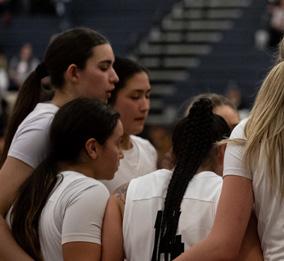
According to Spencer’s obituary, she was born in California, raised in Kent, Washington and later moved to Cle Elum in her teens where she graduated from high school. She pursued a degree in accounting from CWU.
Alex Lange, a friend and colleague of Spencer, said she formed a “sisterhood” with Spencer because they both survived cancer and supported each other on their health journeys. They both worked on the North end of campus as secretaries and would visit with each other often.
“From the moment I met Shelly when she was working at the travel desk, we just instantly struck up a friendship,”
Lange said. “She was so easy to talk to … She had the ability to make kind of a difficult job, something good and something where she could create relationships with people. She was just such a wonderful person, she’d drop anything to help you.”
This sentiment was echoed by the Dean of the College of Education and Professional Studies, Sathy Rajendran.
“My favorite thing about Shelley is that she was a great listener and a great friend,” Rajendran said. “When I started as Department Chair, some days are difficult as we say, leadership can be lonely and those times she was there to listen and support as my staff member. I miss her and can’t think of the ETSC Department without her in Hogue.”
According to ETSC Department Chair Greg Lyman, Spencer had a special way with numbers and students.

“I liked her focus on the students,” Lyman said. “There was always a lot of work to do. She always had a lot of budget stuff she’s working on, and she really focused on when students came in and helping them out, giving them the right direction.”
Administrative Assistant in the office of the Provost Linda Huber confirmed that Spencer was quick to help others even when she didn’t have to. Huber told a story of Spencer volunteering her time to teach employees in other departments about the budget.
”I got the pleasure of know -
ing Shelley for quite a while, probably over 20 years we worked together,” Huber said. “We both worked at the county before we moved to Central. We got to have many conversations about her children and her family. She always liked to share stories about her kids.”
According to the President’s email, “Shelley’s loving wife, Ann, and her two children, Sean and Alayna, were her greatest sources of happiness in life.”
The family will be holding a celebration of life for Spencer in the Spring, and there is a memorial page for her through the Johnston and Williams Funeral Home website for those that wish to send condolences or flowers.
Dr. Stephanie Stein
Dr. Stephanie Stein, esteemed chair of the Psychology department for over two decades, passed away suddenly last Friday, Jan. 6 according to an email sent out by the Provost’s office. As her passing

was so recent and unexpected, details and an obituary have yet to be released publicly.
Associate Professor of Psychology Wendy Williams shared a passage she wrote memorializing Stein’s contributions to CWU and the lives of those around her.

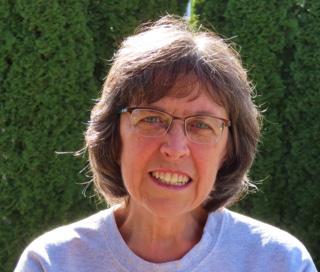
“I have known Stephanie since 1995,” Williams wrote. “We were colleagues and friends. Stephanie was an exemplary Chairperson in psychology. She always kept the well-being of the department and the students at the forefront of her mind. She was respected and liked by her peers and by the administration at CWU.”
“As for me, I will miss my dear friend,” Williams continued. “We raised our children together; she was always the person I turned to for professional and parenting advice. She leaves a huge hole in our hearts. It has been my privilege to know Stephanie and to call her my friend.”
Academic Coordinator and Program Director of IDS-Social Sciences Alena Yastchenko
said she had a unique relationship to Stein because Stein was her advisor as an undergraduate student back in 1992.
“As a student, I appreciated that she was willing to work with me with sorting out foreign university transfer credits, which are so messy and so challenging to figure out how they fit into Central,” Yastchenko said. “She was just really helpful and understanding.”

Yastchenko said Stein had a special approach to being in a leadership position.
“What I appreciated about Stephanie most is that she had this excellent balance between being empathetic, understanding and person-centered with both students and colleagues, but also knowing when to be directive, almost like unyielding … which is rare,” Yastchenko said. “She was never afraid to make tough choices, both in her personal life and in her work life. People responded to that and appreciated that, students and co-workers alike.”
Vol. 124 NO. 1 January 11, 2023 DIVERSITY Frozen walkways affect accessibility on campus Page 3 OPINION What you need to ‘snow’ this winter Page 6 SPORTS Women’s Basketball Surging Through Season Page 7
See pages 5 & 6
Localandcampusorganizations helpthoseinneedduringwinter
Ellensburgexperienced temperaturesbelowfreezingfortendays,accordingtoweatherdatafromAccuWeather. Photo by Andrew Ulstad
Lefttoright:Dr.StephanieSteinandShelleySpencer. Photos courtesy of the CWU website
Beyond Our Coverage
Local National Global
Cle Elum’s Chalet Hotel had a two-alarm fire Monday Morning, according to The Daily Record. Cle Elum Police Department and Fire Department evacuated the building before extinguishing the fire after 3 a.m. The cause of the fire has not been released.
A Fall City woman was killed after a tree fell on her, according to King 5. The incident occurred a little before 9 a.m. on Monday. Members of the Eastside Fire Department performed CPR on her but could not resuscitate her.
An angry man fired gunshots at Taco Bell in Yakima, according to KOMO News. The man was upset that the restaurant was closed and wouldn’t serve him at 2 a.m. on Friday.
Staff

Long
Buffalo Bills safety Damar Hamlin was released from the University of Cincinnati Medical Center on Jan. 9, following a week of recovery and observation, according to CNN. He was hospitalized on Jan. 2 after his heart was restarted during their game against the Cincinnati Bengals.
Approximately 7,000 nurses in New York City have walked off the job and begun striking at Montefiore Medical Center and Mount Sinai Hospital, according to AP News. The nurses are asking for more staffing to reduce patient load.
Abigail Zwerne, an elementary school teacher in Virginia, brought her students to safety after being shot by a 6-year-old student. According two NBC News, Zwerne is now in stable condition.
time no see readers,
According to NPR, England’s government is close to banning single-use plastics in many commercial goods. The ban looks to build on a 2020 law banning stirring sticks, forks and cotton swabs that use single-use plastic.
Rioters flooded into Brazil’s government building on Sunday, according to AP News. After his refusal to accept the election results, supporters of former President Jair Bolsonaro stormed congress, the supreme court and the presidential building.
Climate activists protested to prevent their small German village from being bulldozed, according to AP News. The German government has plans to bulldoze Luetzerath and extend a nearby coal mine. Hundreds of protesters gathered at the demonstration after receiving protest training.
Letter from the Editor
I hope you’ve had a reflective and soothing time throughout the holiday season. Winter is a season to examine what patterns and behaviors no longer serve us and to shed past versions of ourselves. This issue highlights some of the amazing winter programs available on campus and in town to serve community members facing financial insecurity (see pg. 4-5), a guest column about the sentience of animals (see pg. 6) and coverage of our thriving Women’s basketball season (see pg. 7).
We hope you all take care of yourselves during this pivotal time, while many of us on campus are grieving. CWU provides a fantastic resource for students via the TimelyCare app. If you download the app and log in with your CWU email, you can access free scheduled therapy appointments and emergency visits. I’ve used this tool for my mental health many times, and could not recommend it enough.
Take care and be well,
Cat-ivities
Word Search
Student Artwork Submission

Jellyfish in Monterey Bay.
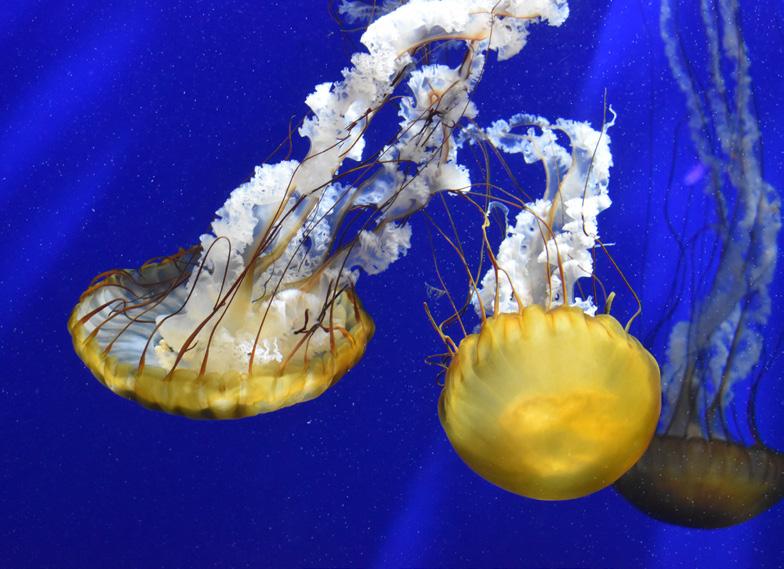 Lead Editor
Lead Editor
November 02, 2022 Page 02
The Observer
Editorial Policy: The Observer is a public forum for student expression, in which student editors make policy and content decisions. The mission of The Observer is two-fold: to serve Central Washington University as a newspaper and to provide training for students who are seeking a career in journalism. The Observer seeks to provide complete, accurate, dependable information to the campus and community; to provide a public forum for the free debate of issues, ideas and problems facing the community at large; and to be the best source of information, education and entertainment news. As a training program, The Observer is the practical application of the theories and principles of journalism. It teaches students to analyze and communicate information that is vital to the decision making of the community at large. It provides a forum for students to learn the ethics, values and skills needed to succeed in their chosen career. If you have questions or concerns, email us at cwuobserver@gmail.com. Lead Editor Katherine Camarata News Editor Morgana Carroll Assistant News Editor Megan Rogers Sports Editor Isaac Hinson Opinion Editor Jacqueline Hixssen Online Editor Madison VanRavenhorst Copy Desk Lead Jacqueline Hixssen Assistant Copy Editor Brittany Cinderella Graphic Design Lead Glacie Kehoe-Padilla Assistant Graphic Designer Brandon Davis Photo Editor Andrew Ulstad Senior Reporter Omar Benitez Staff Reporters Tre Henderson Gavin Johnson Charis Jones Zileni Milupi Joshua Packard Miya Rivera Jordyn Rossmeisl Faculty Adviser Jennifer Green Editorial Consultant Francesco Somaini A LOOK BEYOND @CWUObserver CWU Observer @CWUObserver cwuobserver@gmail.com cwuobserver.com
Katherine Camarata
Photo by Brittany Cinderella
Sharing perspectives Supportingawareness

Frozen walkways affect accessibility on campus Frozen walkways affect accessibility on campus
Every October, Disability Services reaches out to students who have registered that they have a disability that affects their mobility. They compile the information given by students in order to prioritize the walkways that disabled students use when it is time for snow removal.
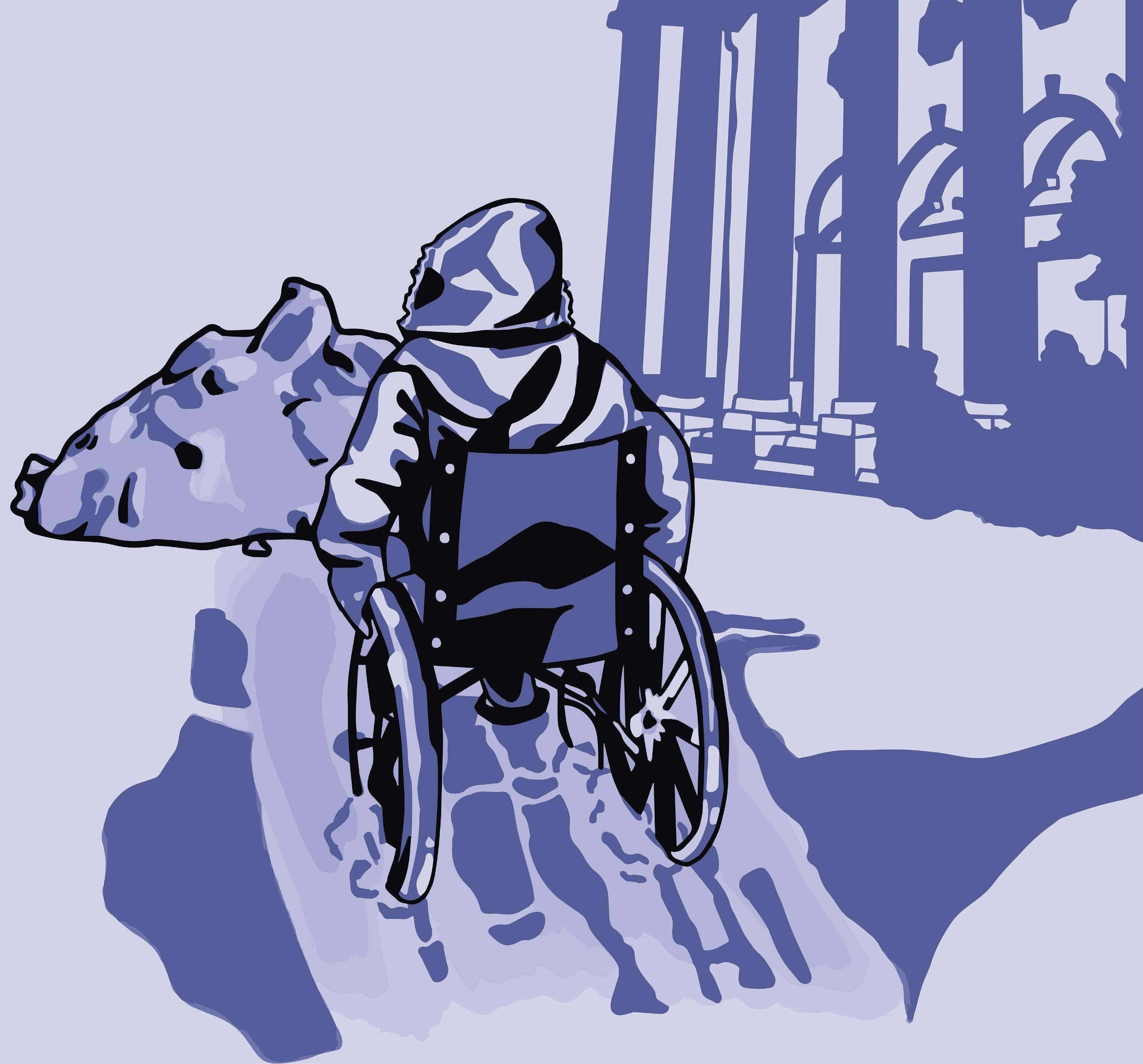
“Snow and ice make it more difficult for everyone to safely navigate campus,” Student Disability Services Manager
Wendy Holden said. “For students with disabilities that impact mobility, the problem can be exacerbated.”
Some students have voiced concerns saying that the ice and snow still make traveling during the winter months difficult.
“[The pathways are] historically awful unless it’s one of the areas with heated pipes underneath,” senior in Physics and Theater Studies Christine Anderson said. “When I lived on North Campus there were many times that I slipped and
fell, especially in the residence hall parking lots and their connected walkways.”
Facilities Director Sunny Bloxham said that they keep a close eye on the weather forecast and show up the night before to plow and sand, usually between 2-4 a.m. For unexpected freezing temperatures, Bloxham said that they work closely with public safety and adapt their plans as needed.
“The facilities team has been very responsive in working with Disability Services when problems are identified,”
Holden said. “Snow removal is a massive undertaking and I have always appreciated the team’s willingness to quickly respond to any accessibility concerns.”
Anderson said that it often felt that the inclined sections that connected sidewalks to other walkways weren’t as thoroughly salted as they should have been and were usually more icy when other parts of the sidewalk weren’t frozen at all.
“Getting to Samuelson from any of the parking lots has
been really interesting since I have 9 a.m. class and it hasn’t warmed up enough most days to have melted yet,” Anderson said. “Because I walk with a cane I often find it sliding out under me, even with the sand they put down.”
According to Holden, it’s not always possible to clear every path on campus, but the main paths are cleared.
“Priority is given to clearing accessible routes, which means the ramp into a building might be cleared before the stairs are,” Holden said.
@CWUObserver CWU Observer @CWUObserver cwuobserver@gmail.com cwuobserver.com DIVERSITY THE PAGE
Page 03 January 11, 2023
Morgana Carroll News Editor
Digital artwork by Makayla Zayic
Local and campus organizations

Wildcat Pantry hosts Pack the Pantry to support student needs
Rogers Assistant News Editor

The Wildcat Pantry, located on the ground floor of the James E. Brooks Library, is hosting Pack the Pantry throughout the month of January, a drive to help bring in food donations and other essential items for the CWU community.


Senior elementary education major and Wildcat Pantry volunteer Daisy Ramirez said, “Our goal is to fill the pantry for this month and have food items that help all students.”
Pack the Pantry is an annual drive, but this year the Wildcat Pantry team is trying something different. The drive will be separated into four weeks, each with its own theme of donations.
According to Ramirez, week one will focus on cultural food and other high-priority items.
Week two will be focused on food allergies and donations will be gluten-free, dairyfree and vegetarian/vegan non-perishable items. Week three will be hygiene and household items such as winter clothes, menstrual products, or toilet paper. Week four will be any items from the categories above.
Wildcat Pantry Coordinator Jaeda Nelson said, “[Wildcat Pantry] wanted to create a different theme every single week
because as much as donations are great, sometimes the variety of those donations or the amount of donations doesn’t always serve our shoppers that are coming in with dietary needs, cultural preferences [or] just other circumstances … We realize that our services should be beyond food and that it needs to support students’ holistic well-being ”
According to Nelson, this drive is a call to action for the community to help out fellow peers and students.
“Last year we were able to raise $30,000, which is a lot more than we could have ever imagined, and it’s a great amount of money but because the pantry operates mainly on donations, once those donations are used, it’s gone,” Nelson said.
Their goal this academic year is to raise $50,000, according to Nelson. The Wildcat Pantry has seen an increase in visits and has been spending $1,000 weekly.
According to a graphic posted by @cwuwildcatpantry on Instagram, throughout Fall quarter visits to the Wildcat pantry increased by 77% and recurring visits have increased by 22%.
Matthew Braganza, a senior accounting major and PUSH secretary and pantry lead, said that having the Wildcat Pantry on campus is important be -
cause food is a basic need and a right.
“There should be little to no expectation for students to pass their classes or even attend clubs or excel in their fields when they’re not meeting their basic needs like food,” Braganza said.
If students or community members want to make donations during Pack the Pantry, donation spots can be found at the locations in the inforgraphic.
January 11, 2023 Page 04
Megan
DONATION LOCATIONS: - Library 101c - Black Hall 101 - The fourth floor of Shaw Smyser - Barge Hall 305 - Reception desk in the Health Sciences Building - SURC service desk or CAT Trax West - Reception desk in the Medical Center - Hogue Hall 115 - University Police Office - The lounge kitchen in the International Building - The first floor south side of the Language and Literature Building.
TheWildcatPantry alsoacceptsmonetary donationsordonations throughtheirAmazon wishlist.
Photo courtesy of Jaeda Nelson
Photo courtesy of Jaeda Nelson
help those in need during winter
APOYO starts new after-school sports
Northwest Expressive Arts Response offers corresponding after school program
Amigos Atléticos or “athletic friends” in English, is a new sports club started by Allied People Offering Year-long Outreach (APOYO) aimed to help youth around Ellensburg get active and spend time outside after the withdrawn nature of the pandemic.

The program was first started by APOYO Administrative Assistant & Amigos Atléticos Program Director Jesus Erasto-García and Assistant Director Fatima Andraca back in September.
APOYO first received funding for the program in July, according to Erasto-García. They prepared for the program throughout last August and September. September 27, 2022 marked their first day of activities.

“We wanted to help rebuild the community after the problems we had that came with COVID-19, and our focus for this program is getting kids back outside after the pandemic that forced many to quarantine and be indoors,” Erasto-García said.
The club hopes to achieve this by meeting three times a week for workouts. Amigos Atléticos also has three meeting locations: the CWU Recreational Center, Morgan Middle School and Garage Studio Fitness.
The workouts include games of dodgeball, basketball, soccer, flag football, pickleball, badminton and group classes at Garage Studio Fitness.
The club is open to any students from the sixth through tenth grade in the Ellensburg area and will last through March.
APOYO is striving to combat the lack of access to extracurricular sports activities for minority and low income students and other underprivileged youth.
Amigos Atléticos is offered to all youth completely free and gives underprivileged youth the opportunity to play sports and go to the gym, a chance they may otherwise might not have.
“I think it’s very hard for some people to access things like gyms and sports clubs, especially if you’re in the low income spectrum of it,” Andraca said. “Having this opportunity helps invite people and lets them know, ‘hey, this option is available for you and it’s all paid for.’”
“With the pandemic and the isolation that many students faced … I think just giving them the opportunity to get out there, do some fitness programs and socialize with other people in their age range could help a lot,” Erasto-García said.
APOYO’s Amigos Atléticos program has partnered with a local nonprofit organization called Northwest Expressive Arts Response (NEAR), an organization that provides mental health counseling and expressive arts programs to immigrant and other underserved populations in Kittitas County and beyond, according to NEAR’s founder Nan Doolittle.
Doolittle said after receiving a $25,000 grant from the Yakima Valley Community Foundation, she offered to use some of the money to create an after school program available to families involved in the Amigos Atléticos program. NEAR’s additional after school program is called “The Thunder Years.”
“So far, students and adults have been hungry to express themselves and have readily built and decorated personal art, danced and moved, listened to music, and shared stories,” Doolittle said.
Any high school or middle school students interested in participating in either program can sign up at apoyo-community.org or by calling APOYO’s office at (509)-201-1820.
Page 05
Omar Benitez with contributions from Katherine Camarata Senior Reporter and Lead Editor
program “Amigos Atléticos” with $22,000
Kittitas County Health Network
grant from
on Facebook
Photo Courtesy of APOYO
APOYOAdministrativeAssistant&AmigosAtleticosProgramDirectorJesus Erasto-GarcíaandAssistantDirectorFatimaAndraca. Photo by Omar Benitez
OPINION SECTION
What you need to ‘snow’ this winter
Whether you’re new to Ellensburg, lived here for a few years or are a permanent resident, you should always make sure to practice proper snow etiquette. After moving here from Sammamish, a town with little to no snow ever, I had to learn from my own mistakes to make sure I was safe on snowy roads.
Always carry a snow brush, even if the snow chances are low.
After checking the forecast, you might think you won’t need a snow brush or a way to clean off your car. As soon as winter temperatures start, put the brush in there. The ideal tool should have an ice scraper on one side, and a brush on the other.
Brush as much snow off of your car as you can reach, even if you’re in a rush to leave.
Snow is really annoying to clean off of any car, especially if it’s icy or a few inches thick, but it can cause an accident if you’re not careful.
The dangerous snow to get rid of is the snow on your windshield and on the roof of your car. With your windshield, if you don’t clear all of the snow off, it can slide to the driver’s side and block your vision. With the roof, if you slam on your brakes, any snow stuck on your roof will blow onto your windshield. Or when you hit the gas, you can blind anyone behind you with snow onto their car. Put your windshield wipers up when you park your car, front and back.
A trick I learned from my parents was to put my windshield
wipers up before leaving my car if it’s going to snow or freeze. As it gets colder outside, ice forms from built-up snow, which can cause your wipers to stick to the window. To avoid this issue, pull both your front wipers and your back wiper off of the window.

Along with your wipers, check that your car has the proper wiper fluid, to avoid it freezing, generally, you’re looking for “deicer” in the title!
Prepare for the worst, expect the best.
No matter how short or long of a trip you’re taking, there’s always a likelihood you’ll get stuck on the roads or on Snoqualmie Pass. To prepare for the worst, grab a blanket, some snacks and spare water bottles for your car at all times. To prepare for the best, pack some warm gloves if you’re naturally cold, and snow boots to keep your feet warm! Keep updated by signing up for WSDOT alerts by texting “WSDOT Snoqualmie” to 468311 or going to https://wsdot.com/ travel/real-time/mountainpasses/Snoqualmie to check Snoqualmie Pass.
Check the roads carefully, and test your brakes!
Along with always carrying chains, it’s important to be careful on the roads. Make sure you’re making no sudden turns, and don’t suddenly brake or accelerate quickly, any sudden movements can cause sliding! If you don’t have chains or aren’t able to put them on, you can also invest in AutoSocks, or check what is permitted by the Department of Transportation!
The moral status of animals
Jampa Dorje Guest Columnist
I was walking along a path deep in conversation with a friend. We were talking about “tigles,” tiny rainbow spheres that can appear during open-eye meditation, when I saw a flash of light shooting down the path, and a young chipmunk ran under the sole of my boot. With its spine crushed, blood running from its mouth, and with it writhing in the dust, I told my friend to walk on ahead, as she’d not want to watch what I was going to do. I’ve lived on farms. It’s considered reasonable to put down a suffering animal.
A blow to the head with a rock, and the creature was still. I dug a small hole, put in a few leaves to make a cushion, and laid the body of the chipmunk in the grave. I said a mantra, and then I covered the chipmunk with earth and placed a cobble on top.
During a Dharma talk, the subject of killing came up, the difference between accidental and intentional acts of killing, so I told about my encounter with the chipmunk, and Adzom Rinpoche, my lama, said that the first act was accidental and didn’t involve me in the animal’s karma in a negative way, but that my decision to put it out of its misery was more serious in its repercussions, that I should have left it ‘to burn out its karma” without interfering in the process. Such is the vast difference in views between East and West.
Not long ago, I attended a talk by Dr. Matthew Altman, one of my professors in the CWU Philosophy and Religious Studies Department, entitled: “Evolving Ethics About Animals: Is ‘Man’ Still the Measure of Everything?” The concept of man being the measure of all things comes from Plato’s “Theaetetus” and is attributed to Protagoras: “Man is the measure of all things: of things which are, that they are, and of things which are not, that they are not” (152a). The idea inherent in this statement is that humans hold the most value in the hierarchy of life.
In “Genesis” 1:26, God installs humans as the rulers over the other animals. Altman pointed out the anthropocentric position of the human animal began to shift after Copernicus formulated a new model of the universe in his “On the Revolutions of the Celestial Spheres” (1543) that demonstrated that our Earth revolved around the Sun. Although Earth was demoted in stature, humans remained the highest of God’s creatures. In his “Treatise on Man” (1647), Descartes portrayed animals as automatons, but humans were special because of their souls. With the publication of Darwin’s “On the Origin of Species” (1859), humans were shown to be a species of animal having evolved
over time from a common set of ape ancestors. Anthropomorphism is no longer tenable.
The question arises: If I am an animal and claim to have inalienable rights, shouldn’t other animals have similar rights? As philosopher Mary Ann Warren defines moral considerability, the following criteria are necessary: Sentience (feel pain and pleasure); Reasoning (have complex memory); Self-motivation (control); Communication with others (e.g., Sign language— Fouts’ research was mentioned); and Self-consciousness (awareness of place). These criteria cannot be extended to all animals, but the higher functions are present in many large mammals and provoke our moral concern around the eating of animals and the use and abuse of animals in research and industry. Altman said that Warren’s criteria are “a continuum, and the more of these you have the clearer it is that you’re a person. You can be a person without all of them, but if you have none of them, you’re probably not a person.”
Altman next discussed the works of Peter Singer and Stephen M. Wise. Singer, author of “Animal Liberation” (1975), is an animal welfare theorist and argues for the utilitarian concept that “the greatest good of the greatest number” is the only measure of practical ethical behavior, and he applies this principle to other animals than humans. The welfare approach to animal rights is less concerned about the element of personhood and focuses on pain and suffering. Wise, a lawyer and author of “Rattling the Cage: Toward Legal Rights for Animals” (2000), defends animals’ legal rights because he thinks many of them, especially those with higher cognitive functions, should be considered persons and research on the higher primates is punitive. The debate about the moral status of animals ranges from the relative positions
of Singer and Wise to an absolutist position that all sentient beings have the right to live.
Near the end of Altman’s talk, an audience member asked if there were approaches from Eastern philosophers, but Altman said he wasn’t comfortable speaking from that perspective. Later, I emailed him and wrote: “My Buddhist take on the subject would be that the view on animal rights is anthropocentric and teleological because of the set goal to liberate all sentient beings from samsara and the concept of humans (among the six classes of beings) as having the shortest route through reincarnation. I allow myself an aesthetic approach to many ethical matters, and here I might suggest that regarding eating meat, it might be considered the height of bad manners to be butchering, serving up, and consuming one’s ancestors. There are strange Tibetan rituals, where meat is an essential ingredient; there are rationalizations that a highly evolved meditator can elevate the mindstream of a less evolved animal; there is a calculus that it is better to eat a cow than a shrimp because it is only one sentient being consumed in many hamburgers against a lot of “sea bugs” in a shrimp cocktail; and there are radical theories about emptiness and the “unborn unborn” that sound to us in the West like Nietzschean madness. Our cowboy culture has led us down a precarious path, and those of us that eat meat would be wise to eat less. And all of us should be thankful for all the sentient life that has perished in the process of becoming something that we eat. Do No Harm is a basic tenet of Buddhism, and Compassion is the means to this end.
Returning to my earlier story about taking on the karma of another sentient being, I guess I have a good likelihood of being reincarnated at a chipmunk.

Page 06 January 11, 2023 @CWUObserver CWU Observer @CWUObserver cwuobserver@gmail.com cwuobserver.com THE
BSERVED
Photo by Brittany Cinderella
Photo courtesy of pexels.com
Brittany Cinderella Columnist
Women’s basketball surging through season
Hinson Sports Editor
While students and staff were away for break, the women’s basketball team continued their dominant season. The Wildcats currently sit at 11-3 and rank fourth in the Great Northwest Athletic Conference (GNAC) with a 3-2 conference record.

Of those 11 wins, eight of them have been won by 20-points or more. Head coach Randi Richardson attributes the massive margin-of-victory to the team’s high-powered offense.
“We have a pretty balanced offense,” said Richardson. “We can shoot the ball at a high-rate from three, and then we have
good guards who can penetrate the lane and get into the paint. As well as an All-American post player [Samantha Bowman] who can score in the paint too, so we put a lot of pressure on people offensively.”
In practice, Richardson says that she focuses on getting the best shots possible, and making sure everyone is comfortable in their role on the team.
“[We emphasize] Shooting the ball and getting great shots,” said Richardson. “As well as making sure players are doing what they’re good at, and not trying to do things that are outside of their skillset.”
Richardson highlighted sophomore guard Valerie “Sunshine”
Huerta as a player who has impressed her this season.
“Sunny Huerta’s really stepped up for us,” said Richardson. “She’s really dynamic. She has the ability to really handle the basketball and get to her spots. She can score at all three levels, from three, off the dribble, and she can get to the rim.”
Huerta is averaging 19.8 points-per-game (PPG) on 47.1% from the field, and an astounding 47.8% from three. Huerta is also averaging 2.7 rebounds-pergame (RPG) and 3.4 assists-pergame (APG).
Richardson says that Huerta’s play has also helped center Samantha Bowman play at a higher level.
“I think her play has also really helped out Sam [Bowman],” said Richardson. “They both help each other out because they put so much pressure on other teams in different ways.”
Bowman is averaging 19.9 PPG, 15.1 RPG, and 2.9 APG as well as 1.7 stocks (Steals + blocks) per game.
Unlike their competition, the Wildcats have yet to be able to play a single game on their home court, due to the reconstruction of Nicholson Pavilion. Richardson credits the team’s ability to continue their impressive play despite the circumstances.
“We’ve been playing in all gyms but our own,” said Richardson. “Our youth don’t know any bet-
ter, they’re just excited to play … We’ve been on the road all year essentially, so it hasn’t really affected us.”
Going into the second half of the season, Richardson says that she wants the team to focus on improving their defensive ability.
“We’ve been fairly sound defensively,” said Richardson. “There’s a lot of room to grow, but we’ve been doing enough to really allow for our offense to impact the game. A lot of it comes with experience and investment. Our schemes have been good, it’s just our execution. So making that a higher priority and giving them extra reps and giving them complete clarity on the defensive end
Jan 7
MBB vs Alaska Fairbanks Win 78-66
Sports Editorial: The Dolphins killed Tua Tagovailoa’s career
Jacqueline Hixssen Columnist
Anyone watching America’s sport this season can admit the abnormal amount of serious injuries.
The Miami Dolphins put Tua Tagovailoa’s life and career on the line after clearing him to return to play in week three’s match-up against the Buffalo Bills and more so, allowing Tagovailoa to play in week four’s game against Cincinnati Bengals.
Tagovailoa, starting quarterback of the Dolphins, has been on the media’s forefront this season and not because of his play on the field.
Tagovailoa’s season, and potentially his career are not guaranteed after the quarterback got hit in week three by Bill’s linebacker Matt Milano.
After Milano’s roughing call,
Tagovailoa was seen stumbling, falling and being supported by teammates as he was escorted off the field.
The National Football League (NFL) has been adamant about preventing head injuries to the players by adjusting helmet capabilities per position; maybe what they need to pull their focus to is the third party specialists teams are hiring to clear players from concussion protocol.
The announcers and fans are, of course, not all medical professionals, but it was obvious that Tagovailoa suffered a concussion; but according to the unaffiliated neurotrauma consultant, Tagovailoa did not suffer a concussion and was entered back into the game during the second half.
The next week during the game versus Bengals, fans saw Tagovailoa being escorted off
the field on a stretcher with a severe head injury.
After Bengal’s lineman Josh Tupou sacked Tagovailoa, Tagovailoa’s hands were seen seizing.
Chris Nowinski, a neuroscientist and CEO of the Concussion Legacy Foundation told Business Insider that, “you usually see it in stroke when you’ve had massive damage to the cortex … Basically it made his cortex no longer in control of his body, and his brain stem took over. And that’s what it does when you have a damaged cortex.”
It seems that the Dolphin’s organization needed Tagovailoa to publicly show his signs of a concussion to bench the quarterback.
Tagovailoa made his short return in week 16 against the Green Bay Packers, but was entered back into concussion protocol after the game.
of
Northwest
clinching a
The biggest
paper, this game should be an easy win for the 49ers; but Seahawks head coach Pete Carroll has coached miracles against the 49ers' Kyle Shanahan before , and this team has momentum riding in their favor just as much as San Francisco does theirs Sadly, down in Portland, the Trail Blazers find themselves on the wrong end of 500 They're 3-7 in their last 10, beating only the bottom of the barrel Houston Rockets, Charlotte Hornets, and Detroit Pistons The team is first in the league in turnovers over their last five games, with 20 a game They've played the most road games in the league, and have remained dealing with injuries to key pieces Justice Winslow, Gary Payton II, and Nassir Little However, the team plays 10 of their next 11 games in the beautiful Moda Center in Portland, and hopefully will be seeing Payton return to playing consistent minutes Does the clock say Dame Time?
@CWUObserver CWU Observer @CWUObserver cwuobserver@gmail.com cwuobserver.com January 11, 2023 SPORTS Page 07
SamanthaBowmanleadsthehuddle. Photo courtesy of Jacob Thompson / Thompson Sports
Isaac
Scores Jan 5 MBB vs Alaska Anchorage Loss 90-72 Win 107 Sports Editor: Isaac Hinson CWU
Sports
Well it appears I have a column now Baller
news coming out
the Pacific
sports world right now is the Seattle Seahawks
playoff berth! They will face division rivals the San Francisco 49ers on FOX Jan 14 at 1:30PM On
Jan 7 WBB vs Simon Fraser Loss 65-57
Hillary Matson (Hillia Hula)


How did you start hula hooping? What drew you to it?
Nearly a decade ago, I passed by a small yard sale at a church in Ellensburg. I stumbled upon a kid’s hula hoop and thought it might be fun to use for exercise. When I got home I looked up hula hooping on Youtube. I came across a Cirque du Soleil video of Elena Lev performing multiple hoops. Her performance mesmerized me because I had never seen a hula hoop used in such a way. It was magical! This kicks off my deep dive into hoop dancing. I ended up buying the proper type of hoop (adult size) and sought any Youtube tutorials I could find. The rest is history.

How do you prepare for a performance?

There are so many working parts to performance preparation. The night before I’m running through the house charging my equipment, loading equipment in the car, making sure I have water, business cards, planning my costuming, etc. The day of the show, I spend a decent amount of time stretching and warming up. I need a couple hours to do hair and makeup, depending on how complex the costume requirements are. A one hour performance could easily take a half day to prep for. There is also mental prep. You aren’t always in the mood to perform, even when you have to.
What is one location you dream to perform at?



I’d love to experience busking in different European countries. I’m fascinated by the idea of performing in historic

places and being part of one of the oldest forms of theatre: street performance. What do you wish more people knew about hula hooping? I wish more people did not assume hula hooping to be a child’s activity. Yes, it can be a child’s
Hooping is a form of meditation, exercise, therapy, dance, self-expression, and art for all ages.
Tell me a bit about your master’s research and how it’s applied to your life as a performer! I got my MA in urban cultural performance studies (an individual studies MA at CWU). I studied the cultural politics of street performers in a corporate-dominated space. My anthropology fieldwork included becoming a street performer. I am not exaggerating by saying it completely changed my life. I did not come back as the same person! One takeaway from my research is that buskers can be both beneficial or a hindrance to corporate environments, depending on if their image and presentation are well or ill-received by the public.
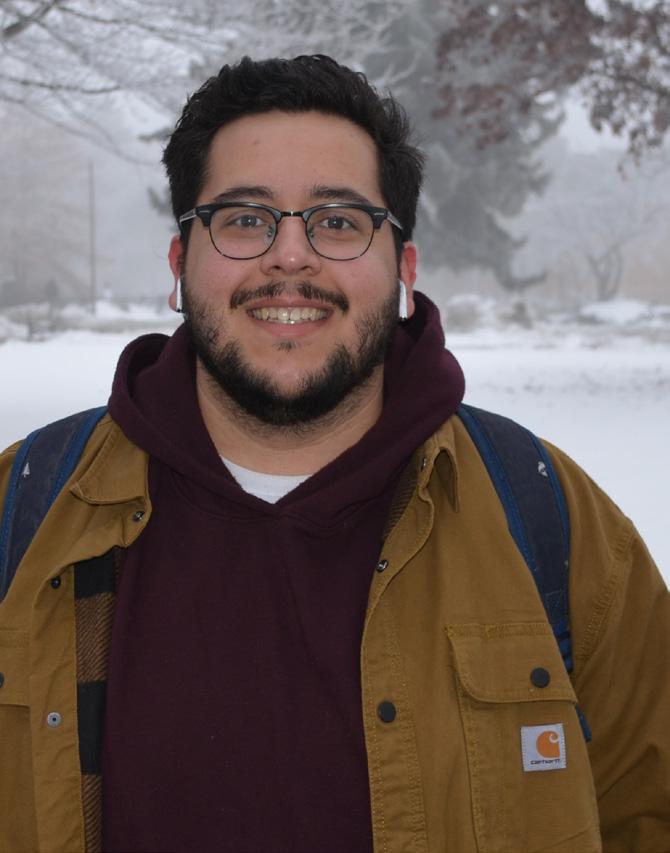
Januarary 11, 2023 EVENTS Page 12 @CWUObserver CWU Observer @CWUObserver cwuobserver@gmail.com cwuobserver.com
Michael Barry Jr.
Computer Science
“I say just the cold, because I gotta walk so far, but other than that it’s fine. The quarter just started, but probably just seeing everybody again.”
Gabriella Plancarte Fr. Competer Science
Asa Smith Jr. Secondary Education English Language Arts
Audrey Robinson Fr. Music Ed and Clarinet Performance
music department right now, there’s a lot and they’re all very fun. The worst part is definitely the weather, it’s depressing.”
Fr. Music Ed “Personally, for me, the best is the weather. I like wintertime, and I know that’s not the same for everyone…the worst thing is everyone is too stuck indoors!” “The worst thing is the cold. Yeah, the weather is Wildcat Words: Submit a letter to the editor or a guest column on our website! Q&Acompiled
What are the best and worst things about winter? 11 THURS 12 FRI 13 SAT 14 SUN 15 MON 17 WED 7-8:30 p.m. - Piano Studio Recital in McIntyre 174 Concert Hall 3:30-5:30 p.m. - WLA Informational Session in SURC 137 7:30 p.m. - Monday Movie Madness: Black Panther Wakanda Forever in SURC Theater weekly events 11:30-2 a.m. - International Cafe in SURC 137A 11am p.m. - 88.1 The Burg Interest Meeting in SURC 201 16 TUES 12 p.m. - Artist Talk in Nuwave Gallery 9 p.m. - HotNew Jam in SURC Theater 3:30-6:30 p.m. - Self Defense Workshop in SURC 137 Q&A Q&A
“I think the best part is all the activities we have in the
Justin Shapen
by
BrittanyCinderella.WildcatWordscompiledbyBrevinRoss.
Anthropology graduate program alum, Administrative Asisstant and professional circus performer
toy, but it is so much more than that.









 Lead Editor
Lead Editor



















